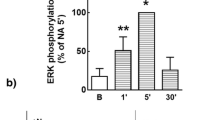Summary
The β-adrenergic receptors, previously shown to be present on the membranes of cultured human epidermal keratinocytes, were found to be functionally coupled to membrane-bound adenylate cyclase. Using membrane preparations, the enzyme could be activated by guanosine triphosphate (GTP), the stable GTP analog GPP(HN)p, and NaF, all of which are known to activate the adenylate cyclase without interacting with membrane receptors. Binding of catecholamine agonists (epinephrine, norepinephrine, and isoproterenol) to the β-adrenergic receptors is followed by an increase in the activity of adenylate cyclase. This activation could be reversed (or prevented) by β-adrenergic antagonists, but was unaffect by the presence of α-adrenergic ligands (either agonists or antagonists). The activation by catecholamines appears to be directly related to receptor occupancy, since the activation constant (K a) of adenylate cyclase for the three catecholamines was found to be very similar to the equilibrium dissociation constant (K d) determined from competition binding experiments. The activation of adenylate cyclase under these conditions appears to be restricted to the catecholamine agonists only. The non-catecholamine β-adrenergic agonists (salbutamol, terbutaline) did not show any measurable activation of adenylate cyclase, even though these agonists were shown previously to bind to the β-adrenergic receptors on keratinocyte membranes with the expected affinities.
Similar content being viewed by others
References
Cavey MT, Gazith J, Cavey D, Shroot B, Reichert U (1984) Receptor-mediated stimulation of adenylate cyclase in cultured human epidermal keratinocytes. J Invest Dermatol 82:564–565
Dowben RM, Gaffey TA, Lynch PA (1968) Isolation of liver and muscle polyribosomes in high yield after cell disruption by nitrogen cavitation. FEBS Letters 2:1–3
Gazith J, Reichert U (1982) High-affinity membrane receptors in cultured human keratinocytes. I. The beta-adrenergic receptors. Br J Dermatol 23 [Suppl]: 125–133
Gazith J, Cavey MT, Cavey D, Shroot B, Reichert U (1983) Characterization of the beta-adrenergic receptors of cultured human epidermal keratinocytes. Biochem Pharmacol 32:3397–3403
Homburger V, Lucas M, Rosenbaum E, Vassent G, Bockaert J (1981) Presence of both beta-1- and beta-2 adrenergic receptors in a single cell type. Mol Pharmacol 20: 463–469
Iizuka H, Adachi K, Halprin KM, Levine V (1976) Histamine (H2)-receptor adenylate cyclase system in pig skin (epidermis). Biochim Biophys Acta 437:150–157
Iizuka H, Adachi R, Koizumi H, Aoyagi T, Ohkawara A, Miura Y (1984) Effects of adenosine and 2′-deoxyadenosine on epidermal keratinocyte proliferation: Its relation to cyclic AMP formation. J Invest Dermatol 82:608–612
Iizuka H, Ohkawara A, Ishibashi Y (1983) Human skin epidermal adenylate cyclase systems: Defective beta-adrenergic responsiveness in the involved epidermis of Derier's disease. In: Seiji M, Bernstein IA (eds) Biochemistry of normal and abnormal epidermal differentiation. University of Tokyo Press, Tokyo, pp 45–59
Kather H, Simon B (1977) Catecholamine-sensitive adenylate cyclase of human fat cell ghosts: A comparative study using different beta-adrenergic agents. Metabolism 26: 1179–1184
Liu SC, Karasek MA (1978) Isolation and growth of adult human epidermal keratinocytes in cell culture. J Invest Dermatol 71:157–162
Lord JT, Ziboh VA (1979) Specific binding of prostaglandin E2 to membrane preparations from human skin: Receptor modulation by UVB irradiation and chemical agents. J Invest Dermatol 73:373–377
Lowry DH, Rosebrough NJ, Farr AL, Randall RJ (1951) Protein measurement with the Folin phenol reagent. J Biol Chem 193:265–275
Nahorski SR (1981) Identification and significance of betaadrenergic subtypes. TIPS 2:95–98
Rheinwald JG, Green H (1975) Serial cultivation of strains of human epidermal keratinocytes: the formation of keratinizing colonies from single cells. Cell 6:331–341
Salomon Y, Londos C, Rodbell M (1974) A highly sensitive adenylate cyclase assay. Anal Biochem 58:541–548
Solanki V, Murray AW (1978) The β-adrenergic receptor of newborn mouse skin. J Invest Dermatol 71:344–346
Solanki V, Murray AW (1982) β-Adrenergic receptors of cultured mouse epidermal cells (HEL/37). Ind J Exp Biol 20:710–713
Takeda J, Adachi K, Halprin KM, Levine V, Woodyard C (1983) Adenylate cyclase activation by cholera toxin in pig epidermis: An obligatory role of the GTP regulatory protein. J Invest Dermatol 81:131–136
Author information
Authors and Affiliations
Rights and permissions
About this article
Cite this article
Cavey, M.T., Cavey, D., Shroot, B. et al. Receptor-linked adenylate cyclase in the membranes of cultured human epidermal keratinocytes. Arch Dermatol Res 278, 293–297 (1986). https://doi.org/10.1007/BF00407740
Received:
Issue Date:
DOI: https://doi.org/10.1007/BF00407740




